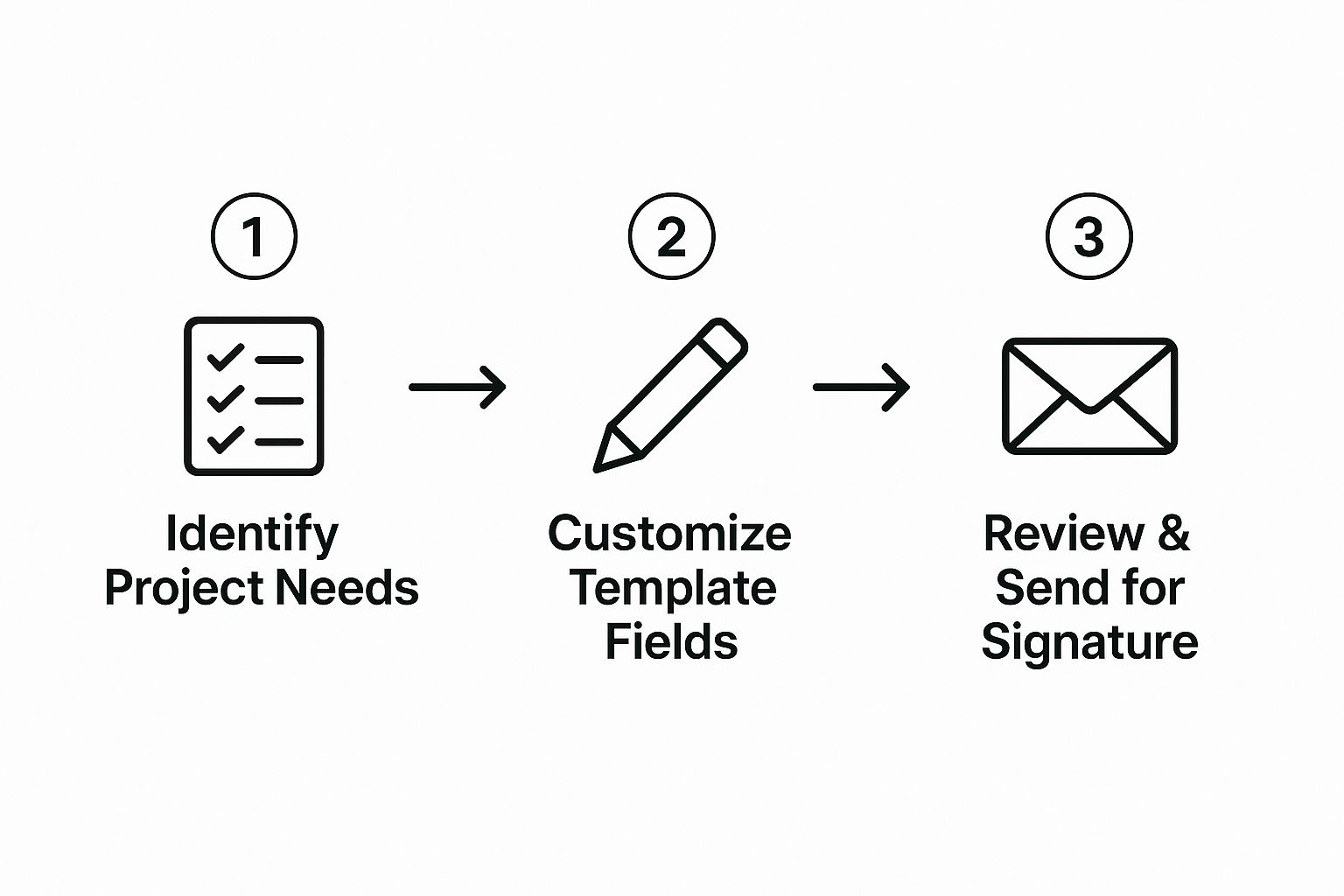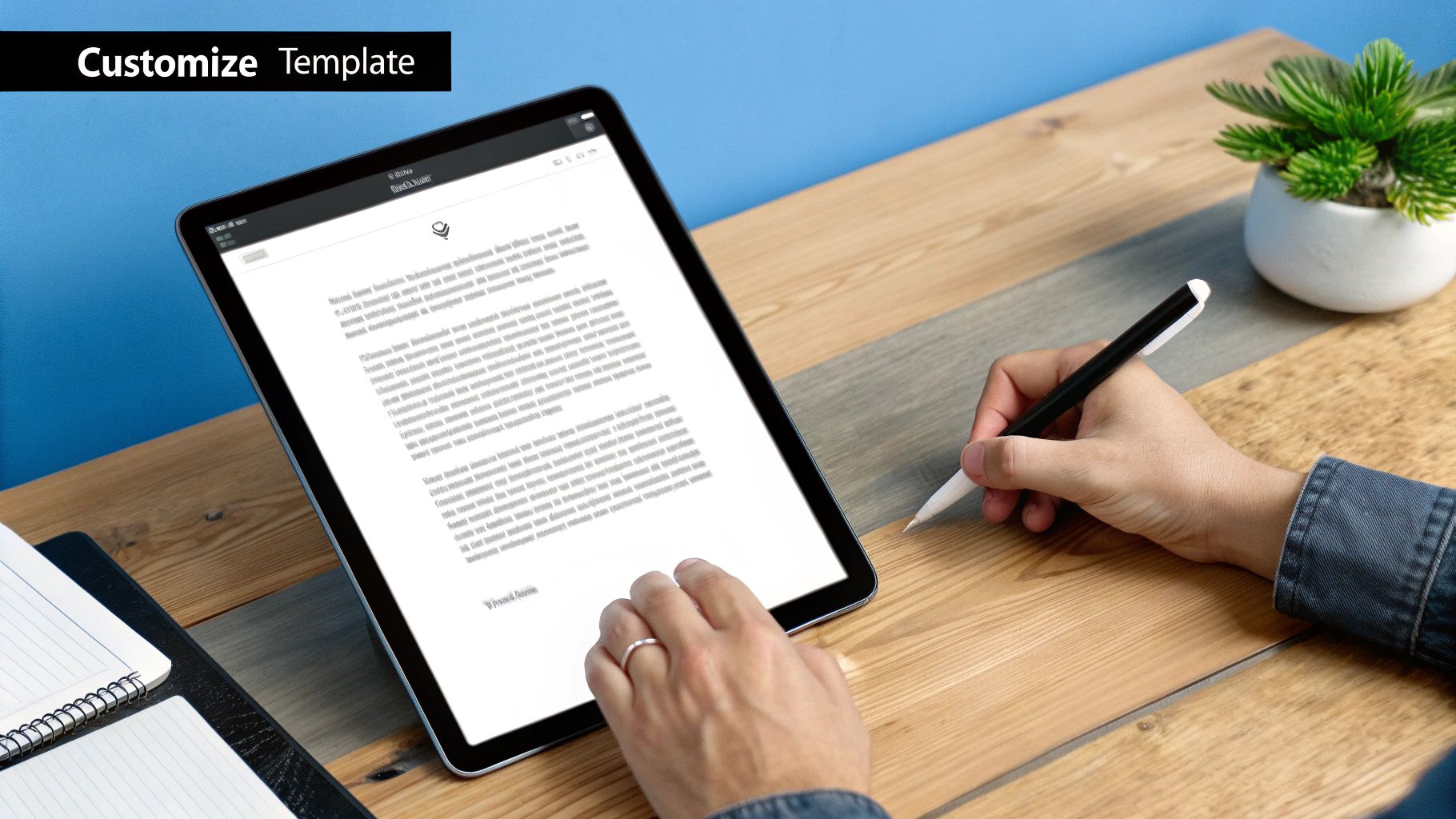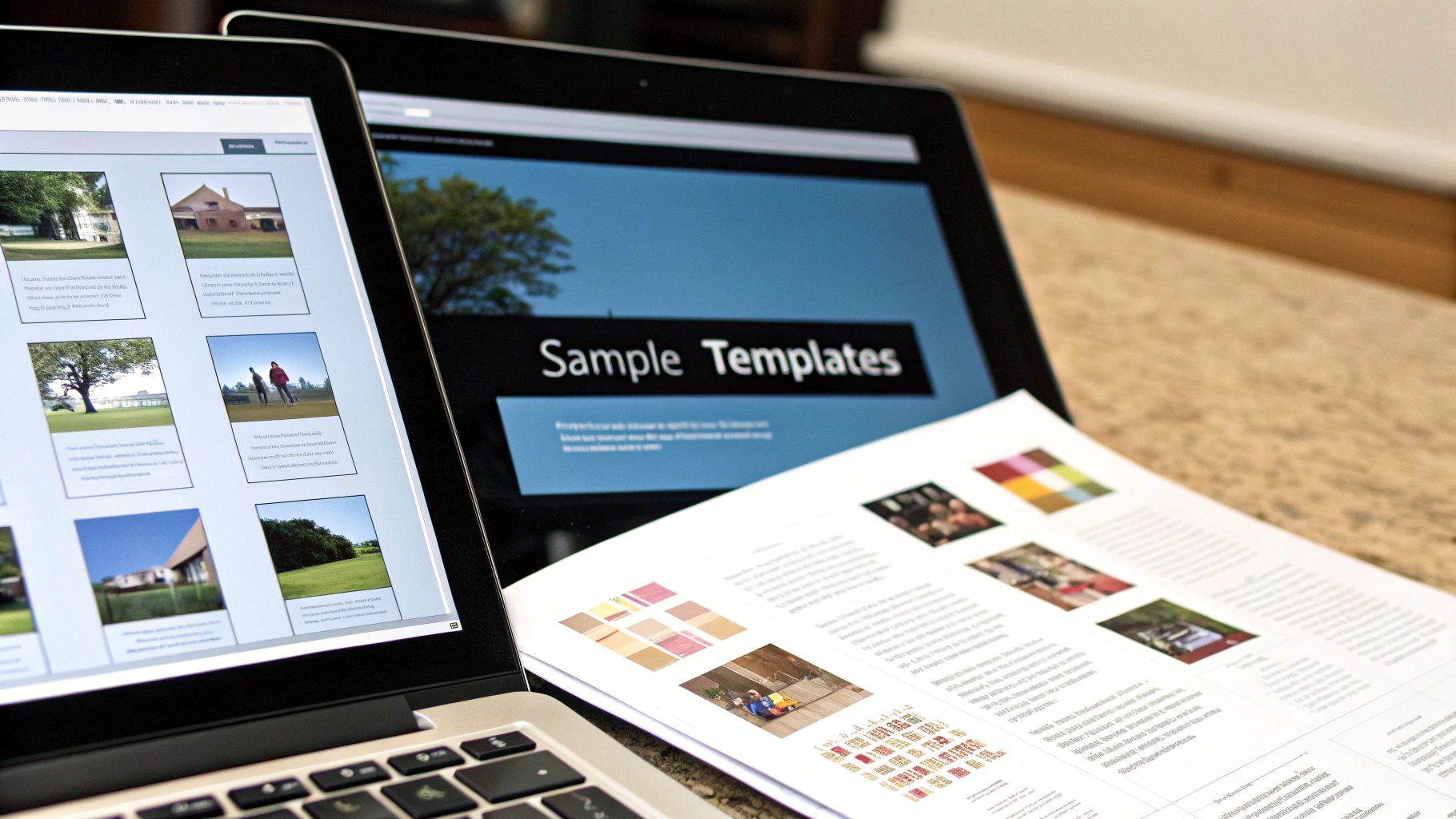Spending hours piecing together proposals and contracts, only to have a hot lead go cold while they wait? You're not alone. That manual grind of creating documents from scratch is a massive bottleneck that costs you time and deals.
But what if you could cut your proposal creation time by 75% today? The quick win is simple: stop starting from zero. By creating a reusable template with just five core sections, you can send professional, error-free proposals in minutes, not hours. Let's build that system right now.
Core Components of a Reusable Template
Every great proposal and contract template is built on a solid, repeatable foundation. Nailing these sections first means you have a reliable starting point that you can then quickly tailor for each new client.
Here’s a look at the non-negotiable pieces you'll want to include.
| Core Components of a Reusable Template | ||
|---|---|---|
| Component | Purpose | Example Content |
| Cover Page & Intro | This is your first impression. It introduces your brand and sets a professional tone right away. | Your logo, client's name, project title, and a short, punchy "About Us" paragraph. |
| Scope of Services | Your best defense against scope creep. Clearly define what you will and won't be doing. | A detailed breakdown of deliverables, project phases, and specific tasks. Be explicit! |
| Project Timeline | Manages expectations from day one by outlining key milestones and delivery dates. | A visual or high-level timeline showing kickoff, review periods, and the final completion date. |
| Investment & Terms | Lays out all costs, how you expect to be paid, and when. No room for ambiguity here. | A simple pricing table with a clear payment schedule (e.g., 50% upfront, 50% on completion). |
| Signature Block | This is what makes it official and legally binding. | A clear, formal section for both parties to sign and date. Digital signature fields are a must. |
Once you have these core elements locked in, you have a powerful tool at your disposal.
Pro Tip: Build in Upsells
Create "optional" sections in your template for common upsells. For example, have a pre-written "Advanced SEO Package" or "Extended Support Plan" section ready to go. You can easily add or remove it depending on the client's needs, making it simple to offer tiered options and increase your average deal size without building a new document.
By taking the time to build this foundational proposal and contract template, you're creating a scalable system for bringing in new business.
Building Your Core Proposal and Contract Template: A Step-by-Step Guide
Let's get actionable and build the template that will save you hours. Staring at a blank page is where most people get stuck. But you don't need a perfect, one-size-fits-all document. What you need is a solid 90% solution—a core template that only needs a few quick tweaks for each new client.
Step 1: Define a Bulletproof Scope of Work
Your scope of work is the most critical part of your template. This is what saves you from scope creep and frustrating misunderstandings. The key is to be clear about what you will do and what you won't do.
If you're looking for inspiration on how to structure this, checking out some different project scope document templates can give you a great starting point.
Here’s what to include:
- Project Objectives: A 1-2 sentence summary of the goal.
- Key Deliverables: A bulleted list of tangible outcomes (e.g., "Five-page responsive website," "Final logo files in .AI and .PNG formats.").
- Exclusions: Explicitly state what's not included (e.g., "This scope does not cover copywriting, stock photo licensing, or hosting fees.").
- Client Responsibilities: List what you need from them (e.g., "Client will provide all brand assets within 7 business days of kickoff.").
Step 2: Nail Down Payment and Project Timelines
After the scope, your payment terms and timeline are the next most important sections. Make them impossible to misinterpret to avoid awkward money conversations later.
A well-structured template doesn't just save you time—it acts as a silent salesperson, reinforcing your professionalism and building trust before you even write a line of code or design a single pixel.
The image below shows how a good template streamlines the entire process, from identifying needs to getting a signature. In growlio.io, you can see this workflow in your dashboard, tracking every document's status in real-time.

This really shows how a solid template becomes the foundation for a repeatable, efficient system. It transforms a tedious manual task into a smooth, professional workflow.
Integrating Your Brand to Build Trust Instantly
A generic, unbranded proposal can make your business look amateur, quietly chipping away at a client’s confidence before they read the first line. Your proposal and contract template isn't just a legal document—it's a critical marketing touchpoint that signals professionalism. In fact, consistent brand presentation can increase revenue by up to 33%.

Actionable Steps for Branding Your Template
Transforming your template from forgettable to fantastic is easier than you might think. Here’s how to do it step-by-step:
- Logo Placement: Add your high-resolution logo to the header or cover page.
- Brand Colors: Use your main brand color for headings (H2s and H3s) to add visual interest.
- Consistent Typography: Use the same font family that’s on your website for a seamless brand experience.
- Reflect Your Voice: Ensure the language matches your brand's tone—whether it's friendly and approachable or formal and corporate.
A strong brand is one of the most effective strategies for building customer trust, and these small visual cues are a huge part of that.
Pro Tip: Brand the Footer
Create a custom branded footer for every page. Include your company name, website, and contact information. It’s a subtle touch that reinforces your brand and makes your document feel official and thoroughly considered from top to bottom.
This level of professionalism adds authority and gives the client extra confidence in your process.
Making Your Template Legally Sound and Secure
Ever get that sinking feeling after sending a contract, wondering if a vague clause could come back to haunt you? A solid proposal and contract template is your first line of defense against scope creep, disputes, and liability. You don't need a law degree to get the basics right—you just need to know which clauses matter.

Step 3: Add Essential Legal Clauses
Here are the non-negotiable clauses every template needs, explained in plain English.
- Confidentiality Clause: Your "what's said here, stays here" agreement. It protects sensitive information you and your client share.
- Termination Clause: Outlines how either party can end the agreement, the notice required, and how you'll be paid for work already completed.
- Limitation of Liability: Caps the amount of financial damages you could be responsible for if something goes wrong. This is crucial for protecting your business.
- Intellectual Property (IP) Rights: Clarifies who owns the final work and when that ownership transfers (e.g., upon final payment).
These four clauses are the backbone of a secure agreement.
Real-World Use Case: The IP Dispute
A freelance developer I know got into a brutal IP dispute. His contract was fuzzy on when the ownership of the code he built officially transferred. When the client was late on their final payment, he assumed he still owned the code. The client had already integrated it into their platform. The legal headache that followed cost him thousands.
After that, he updated his template with an ironclad IP clause: all rights transfer to the client only after the final invoice is paid in full. This simple fix has saved him from similar disasters ever since.
Jurisdiction and When to Call in a Lawyer
Laws vary by location, so include a "Governing Law" or "Jurisdiction" clause specifying which state or country's laws apply. And remember, this guide isn't a substitute for legal advice. For high-stakes projects, investing in a one-time review from a legal professional is non-negotiable.
Pro Tip: Use Dynamic Clauses
In a tool like growlio.io, you can create variable clause blocks. For instance, your "Standard" package might have a basic liability clause, while an "Enterprise" package includes stricter confidentiality terms. This allows you to build dynamic, legally robust contracts without starting from scratch. For more on this, check out our guide on essential contract management software features.
With these protections in place, you can focus on what you do best, knowing your hard work is secure.
Step 4: Automate Your Workflow
Frantically searching a shared drive for the right template and making copy-paste errors is unprofessional. The fix is simple: stop treating your template as a static document and start treating it as the foundation for a dynamic, automated workflow. The real power comes when you plug that template into a system designed to eliminate manual entry.
This is what a central dashboard looks like in growlio. It completely shifts the process from a manual headache to an organized, automated system. The screenshot below shows how you can see at a glance which proposals are drafts, waiting for a signature, or approved, so no lead ever slips through the cracks.

This isn't just a niche trend. The global contract management software market hit USD 2.83 billion in 2024 and is projected to grow at a CAGR of 12.7% through 2030, according to research from Grand View Research.
Still Have Questions About Proposal Templates?
It's one thing to build a new proposal and contract template; it's another to feel completely confident using it. Let's clear up a few common questions.
Can I Just Use a Generic Template I Find Online?
Tempting, but you get what you pay for. Free templates are a rough starting point, not a finished product. They often lack industry-specific clauses and do nothing for your brand. Use them for structural inspiration, then build your own branded version and have a legal pro give it a once-over.
What's the Real Difference Between a Proposal and a Contract?
A proposal is your sales pitch. A contract is the legally binding agreement. The modern, streamlined approach is to combine them. A hybrid document where the proposal becomes the contract upon signature cuts out an entire step and gets projects kicked off faster.
How Often Should I Be Updating My Template?
Review your template at least once a year, or anytime you make a significant business change like adding new services, updating pricing, or changing internal processes. Staying on top of this is a vital part of protecting your business and is a cornerstone of great client service. For more, see our guide on client relationship management tips.
Ready to stop wrestling with documents and start winning more clients? The best proposal and contract template is one that’s integrated into a seamless workflow. growlio.io gives you the tools to build, automate, and track every proposal, from draft to signature. Start your free growlio.io account today and see how easy it is to manage your entire client lifecycle from a single, intuitive platform.
